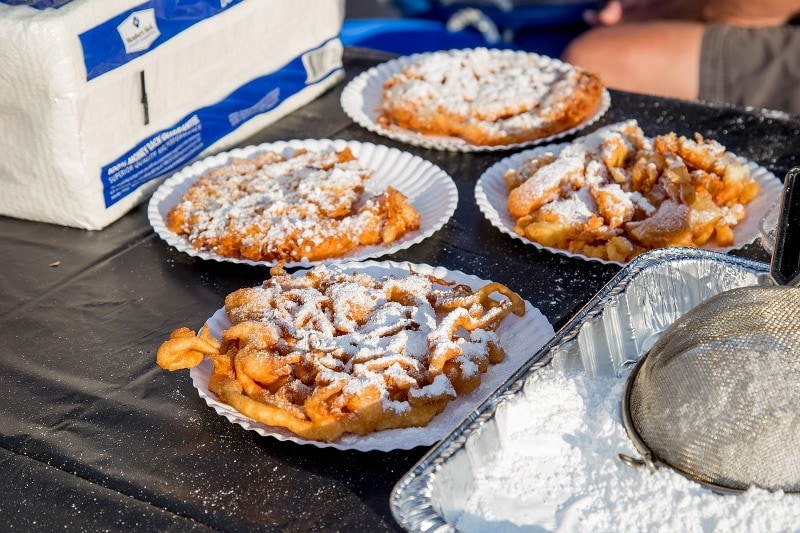Deep frying, and especially deep-fried desserts, are now fully embedded within America’s culinary identity.
The American obsession with the many variations of sweet fried dough like doughnuts, zeppoles, and funnel cakes has its early origins at the world’s fair held in Chicago in 1893. Several decades later, at the 1934 Chicago World’s Fair, the doughnut was crowned the “Hit Food of the Century.”
Since that time, America’s love for deep-fried desserts has exploded. You can now find a plethora of options that include the traditional, the decadent and, sometimes, the utterly bizarre.
Visit a state fair, carnival, or amusement park and you can sample deep-fried Oreos, deep-fried cheesecake bites, deep-fried twinkies or even deep-fried cookie dough.
Many of these desserts are new creations, but there is a whole world of deep-fried desserts whose origins stretch back decades, and in some instances, centuries.
What Are Deep-Fried Desserts?
In its simplest form, deep-fried desserts are a category of cooked dessert, most often of a yeasted dough, that are deep-fried in a hot fat like lard or oil. According to Wikipedia, deep fried foods “cook quickly – all sides of the food are cooked simultaneously as oil has a high rate of heat conduction.”
The preservative effects of deep-frying food also made it a great cooking option. Food Infotech mentioned in their article, Frying Technology: History and Advances Over Time, that deep-fried foods benefit from “the thermal destruction of microorganisms and enzymes, in addition to a reduction of water activity on the food surface.”
A variation of deep-fried desserts can be found in every culture and in almost every country throughout the world. Deep-fried desserts’ popularity is a testament to the simplicity of its ingredients– often consisting of flour, water, and hot oil – mixed with its sheer versatility.

Around the World With Deep-Fried Desserts
We compiled below a list of deep-fried desserts from around the globe. These desserts come in all shapes, sizes, and flavors.
A few of these deep-fried desserts may be familiar, but many will only be known to proficient world travelers or highly informed gastronomes. How many of these delectable desserts have you tried?
| Name | Country of Origin | Description |
| Akara | West Africa | Fried pea flour dough |
| Awameh | Middle East | Deep-fried dough soaked in syrup or honey |
| Bambalouni | Tunisia | Sweet donut sprinkled with sugar or honey |
| Bannock/Fry bread | First Nations/N. America | Deep-fried flat dough |
| Beignet | France | Pillow of fried dough that is light and eggy |
| Bolinho de chuva | Brazil | Deep-fried sweet dough balls |
| Boortsog | Mongolia/Central Asia | Deep-fried mound of sweet dough |
| Buñuelo | Spain | Wheat-based yeast dough flavored with anise |
| Chruściki | Poland | Fried flat crispy dough sprinkled with sugar |
| Churros | Mexico | Piped thin colander of deep-fried dough |
| Fastnachts | Germany | Yeasted dough cooked golden-brown |
| Flancati | Slovenia | Fried yeasted dough topped with sugar |
| Gogoşi | Romania | Round fried dough topped with sugar or filled |
| Jalebi | India/Pakistan | Fried sweet batter with rose water and saffron |
| Loukoumades | Greece | Fried dough balls soaked with honey or syrup |
| Malasada | Portugal | Raised doughnuts |
| Mendazi | Uganda/Tanzania | Dough fried into ball or square |
| Paczki | Poland | Dense jelly-filled doughnut |
| Picarones | Peru | Ring-shaped pumpkin fritter |
| Sata andagi | Japan | Fried dough in a ball shape |
| Touton | Canada | Fried bits of leftover bread dough |
| Youtiao | China | Twisted and fried eggy dough piece |
| Zeppole | Italy | Fried dough ball topped with powdered sugar, and may be filled with custard, cream or jelly |
Sources: EAT Magazine, NPR, Insider, and Wikipedia.
The fact that deep-fried desserts are so ubiquitous, begs the question: where and when did deep-fried desserts originate? Who made it first?
The Origination of Deep-Fried Desserts
It will come as no surprise that the origin stories for deep-fried desserts are as plentiful and varied as the above dessert list.
But, do not worry. We have done all the hard work. Below is an overview of the prevailing theories on the who, what, when, and where of deep-fried desserts and their evolution throughout the centuries.
Mesopotamia
One of the prevailing theories on the origins of deep-fried desserts, and more broadly fried foods, traces frying back to ancient Mesopotamia.
Between 8000 and 5500 BC, the ancient Mesopotamians invented a type of pottery that allowed oil to be heated to a temperature capable of frying foods.
A tomb, dating to the 4th century, produced the oldest known deep fryer. Mesopotamians were also known for using copper frying pans
Various types of dough were among the early food items the Mesopotamians fried. However, there is no evidence to suggest these doughs were sweetened and used as a type of dessert.
Egypt
While Mesopotamia is likely the birthplace of fried foods and frying pans, it appears the ancient Egyptians were the first to utilize the fry method to create desserts.
Starting in the Old Kingdom, around 2500 BC, a type of fried cake, pastry, or donut was served and consumed by Egyptian elites during celebrations like the Thoth, Wag or Sokar festivals.
These ancient deep-fried desserts did not contain sugar, but were, instead, sweetened with honey or dates.
Canaan/Israel
There is some evidence to suggest the first deep-fried dough, Zalabiyeh, appeared around 2000 to 1000 BC in the ancient area of Canaan. Today, this area includes modern-day Israel, the West Bank, Gaza, Jordan, southern Syria, and southern Lebanon.
Greeks & Romans
Both the ancient Greeks and Romans made fried cakes with honey. Different versions of these sweet treats would eventually make their way throughout Europe as both cultures expanded their borders.
Although evidence of fried cakes, fritters, and sweet breads is found among the Greek and Roman diets, deep-fried desserts did not originate with either group.
Romans were introduced to deep frying by the Egyptians. This would lead to the Roman scriblita, considered to be an early precursor to fritters. They were documented in Roman texts as early as the 2nd Century BC. Scriblita was made by dropping a spoonful of sourdough-leavened dough into hot fat.
As the Greeks began to trade goods with the Roman Empire, they were introduced to the deep-frying process. Alexander The Great was also instrumental in the expansion of deep-fried foods in the Greek diet based on his time spent in Egypt. The Greek loukoumades originated around the same time as the first Olympic games that were held in 776 BC.

Early Origins of Deep-Fried Desserts in America
As deep-fried desserts began their spread across Europe and Asia, it was only a matter of time before they reached America.
What we know today as the funnel cake, was one of the early examples of a deep-fried dessert brought to America by the waves of successive immigrants.
Germans, later termed Pennsylvania Dutch, settled in Pennsylvania in the 17th/18th centuries. Their dessert, drechter kuche, were made from a pancake-type batter poured through a funnel into hot oil – hence the name, funnel cake.
Another early deep-fried dessert introduced to America was the doughnut. The Dutch, who established New Netherlands, made oliekoecken or oil cakes. They were made of a yeasted dough and contained spices, dried fruits, and were dusted with sugar.
The dough was dropped into the hot oil and formed into irregular sized balls. The Dutch served these oliekoecken during their Christmas season and during special occasions.
Italian immigrants would also bring with them a host of deep-fried deserts like zeppole, bignè of San Giuseppe and struffoli. Many of these desserts were synonymous with holidays and religious celebrations.
Zeppole were often served on March 19th in honor of the Feast of Saint Joseph, an official Catholic holiday in Italy since 1479.

Get Yours Today!
Now that we’ve talked all about deep-fried desserts, is your mouth watering for one of these delectable treats? Guess what? You are in luck. With just a few clicks you can now enjoy your very own zeppoles.
Boardwalk Zeppoles, a New Jersey-based and family-owned company, is bringing zeppoles, the traditional Italian dessert, right to your doorstep.
Boardwalk Zeppoles’ traditional Italian recipe was perfected by owner, Maria Pacillo, to capture the full Zeppole experience. Sit back and be transported to the New Jersey boardwalk or a state fair with the piping hot crunchy taste of these authentic Italian donuts.
With Boardwalk Zeppoles you can go from freezer to oven to table in a mere 12 minutes.
Enjoy your Boardwalk Zeppoles the traditional way with powdered sugar or pair them with one of our delectable dessert dips found on our blog. You will love the Easy Peanut Butter Nutella Oreo Dip or the Holiday Fall Pumpkin dip.
Zeppoles will be a hit at all your family celebrations and game day gatherings.
CLICK HERE to order your Boardwalk Zeppoles now!




